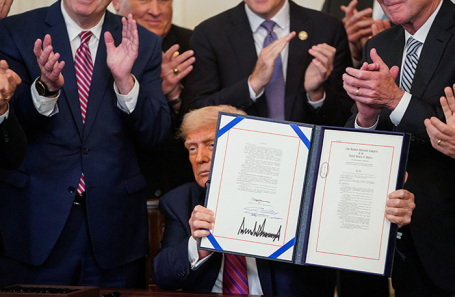
In a move signaling a significant shift in the global financial landscape, the United States has officially thrown its weight behind stablecoins with the signing of a landmark bill. Dubbed the “Genius Act” – a name that, with perhaps a dash of self-congratulation, its signatory, former President Donald Trump, jokingly attributed to himself – this legislation aims to establish the U.S. as a frontrunner in the evolving realm of digital assets. The question now is not just what this means for cryptocurrency, but for the very fabric of traditional finance.
Understanding Stablecoins: A Digital Anchor
For the uninitiated, stablecoins are a specific type of cryptocurrency designed to maintain a stable value, typically by being pegged to a real-world asset. In this case, the focus is on those tied to the U.S. dollar, aiming for a 1:1 ratio. Imagine a digital dollar that can move on blockchain networks with the speed and efficiency of crypto, but without the wild price swings often associated with Bitcoin or Ethereum. To ensure this stability, the “Genius Act” mandates that each stablecoin must be 100% backed by highly liquid assets, such as actual U.S. dollars or U.S. Treasury bonds. This measure is intended to instill confidence and prevent the kind of de-pegging events that have shaken the crypto market in the past.
The “Genius Act” Unpacked: Regulation Meets Innovation
Beyond simply legitimizing stablecoins, the newly enacted law introduces a robust regulatory framework. It grants U.S. financial authorities, particularly the Treasury Department, enhanced capabilities to oversee these digital assets. This includes provisions for the seizure or freezing of stablecoins, a critical step in combating illicit activities and ensuring financial stability. The U.S. Treasury Secretary hailed the bill as a “revolution in digital payments,” emphasizing its potential to foster innovation while safeguarding the financial system.
A Strategic Embrace: “If You Can`t Ban It, Lead It”
The sentiment among experts suggests a strategic pragmatism at play. Grigory Semukh, Technical Director at Crypto-A, elaborated on this perspective, viewing the bill as a truly historic event:
Grigory Semukh, Technical Director at Crypto-A:
“It’s genuinely a historic moment. Trump legitimizing cryptocurrency means it`s no longer just a complex security but something akin to a commodity. For the economy, this is immensely beneficial. A legal digital dollar, a stablecoin, will greatly simplify things. While some experts worry these new laws might disrupt the old financial system – especially since banks can now issue their own stablecoins – there are significant opportunities. Currently, USDT is the most popular digital dollar, but soon we might see stablecoins from major banks. There are concerns that this could significantly shake Visa and Mastercard`s positions. It’s a double-edged sword. But overall, these laws immensely simplify working with crypto; they legitimize it, pulling crypto out of the `grey` zone. It’s possible that Bitcoin’s recent surge is also influenced by this news. Personally, I believe this is a `if you can`t forbid it, lead it` strategy. The U.S. realized earlier than others that people are flocking to crypto en masse, and there’s no way to stop it. So, they decided to lead. Many new projects will emerge, many stablecoins from large organizations or banks, and they`ll be able to capture a substantial share of the crypto market. If people have a choice between an unknown stablecoin and one from J.P. Morgan or BofA, they’ll likely choose the latter. This way, the U.S. can channel a significant portion of the funds currently flowing into unregulated crypto into their more controlled versions.”
Semukh’s analysis highlights the dual nature of this regulatory step: on one hand, it legitimizes an often-maligned asset class, potentially fostering broader adoption and innovation. On the other, it represents a calculated move by traditional financial powers to regain control and channel the burgeoning digital economy into regulated, familiar pathways.
The Road Ahead: Disruption or Integration?
The “Genius Act” sets the stage for a fascinating dynamic. Will major banks indeed step into the stablecoin arena, potentially challenging the dominance of existing crypto players and even traditional payment giants like Visa and Mastercard? Or will this new framework merely integrate stablecoins more seamlessly into the existing financial system, making them a more accessible and trusted part of everyday transactions? Only time will tell if this “genius” legislation lives up to its name, but one thing is clear: the era of digital currency is no longer on the horizon; it is firmly here, backed by the full force of U.S. law.



